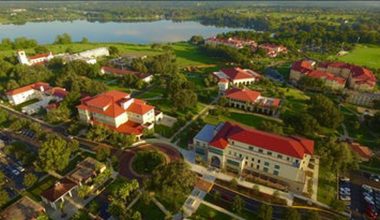For most international students, Sweden is one fascinating country to study and earn world-recognized certificates. One may ask, what is so fascinating about Sweden? Well, university rankings across the globe shows that Sweden is home to some great universities that stood the test of time.
Hence, this article will proffer information on why you should study in Sweden, how much it may cost and each schools’ link to help you apply immediately. So, if you can cope with its very cold weather, here is a list of the best universities in Sweden.
Sweden is a Scandinavian country in Northern Europe. It shares boundaries with Norway and Finland. It is the third-largest country in the European Union by area, she has a population of about 9.5 million.
Sweden is a Scandinavian nation with thousands of coastal islands and inland lakes, along with vast boreal forests and glaciated mountains. Its principal cities, eastern capital Stockholm and southwestern Gothenburg and Malmö, are all coastal.
Why Should I Study in Sweden?
Studying in Sweden differs from studying in other countries because Swedish universities have an open climate with a strong focus on group work. In fact, there are quite a number of reasons why you should consider studying in Sweden.
Some of these reasons include but not limited to:
The Swedish education system focuses more on your academic pursuits than pushing you to achieve a grade. Swedish universities work to prepare you for a successful future; the job market values, ambitious, innovative, and perceptive team players.
Degree programs in Sweden offer students the opportunity to mix study and practical work so that they have experience in their field when they graduate and enter the job market.
The education system in Sweden is student-centric. The relationship between students and teachers is usually friendly and informal.
Furthermore, if you choose to study in Sweden, you will be required to take an active role and participate in your opinions and ideas in lectures, seminars, and group discussions. This will proffer you the opportunity to develop your individual strengths and cultivate your academic abilities.
Sweden is one of the world’s most advanced countries and home to many successful corporations. A number of successful inventions have resulted from research at Swedish universities and companies, including the computer mouse, Bluetooth, the pacemaker, the ball bearing, the dialysis machine, and internet applications such as Spotify and Skype.
These recent inventions are built on a long history of distinction in academia and research in Sweden. Sweden is the home of the Nobel prize and many highly acclaimed universities dating back to the 15th century.
If you are an international student from a European Union country, you have another good reason to study in Sweden: tuition is free
What does it cost to study in Sweden?
Basically, higher education costs in Sweden vary depending on the university and program. Generally, tuition fees in Sweden range from approximately SEK 80,000 per year (approximately 8,300 EUR or 9,200 USD ) to SEK 130,000 (or approximately 13,000 EUR or $14,600 USD).
All students in Sweden need to buy their own textbooks and on average spend 750 SEK/month for this purpose.
Other costs of studying in Sweden
Students normally join the local student union for a small membership fee. This gives you the path to many student activities and student discounts. Fees range from SEK 50-350 per semester, depending on the union.
Living costs depend on the location of study (bigger cities are generally more costly) but are approximately 8000 SEK per month including rent or 925 USD/830 EUR.
The cost of healthcare for international students differs depending on whether you are an EU/EEA/Swiss citizen or not and the duration of your studies in Sweden.
You can apply for a Fee Waiver at Sweden Universities.
Where is Sweden ranked in education?
Sweden has 12 universities in the overall Times Higher Education World University Rankings. The highest-ranking university in Sweden is Karolinska Institute, which is ranked at number 41. Choosing where to study for a degree in Sweden is one of the biggest decisions you will ever make.
Are there Universities in Sweden for Ph.D. programs?
Ph.D. programs in Sweden are usually research-based because you will spend most of your time performing research toward your final dissertation. This will usually take a minimum of four years of full-time work (or 240 ECTS credits).
Here are some schools that offer Ph.D. programs in Sweden
What are the Best Universities in Sweden for International Students?
Well, from statistics garnered from world university rankings, schools acceptance rate, tuition fee, number of programs, accreditation status and the university’s graduation rate, the schools below are some of the universities best for international students.
Here is a list of the best Universities in Sweden for International students.
Read: Scholarship opportunities for International Students in Sweden.
#1. Karolinska Institute
The Karolinska Institute prides itself on its world-class medical research. It regularly ranks as one of the best and most prestigious universities in the world to study medicine.
Based in Solna, near the city of Stockholm, the university was established in 1810 to train army surgeons. It has since grown to include two campuses – the second is in Flemingsberg, further south of Stockholm.
The university offers a range of health and life sciences degrees and postgraduate qualifications. For undergraduates, this consists of medicine, psychology, psychotherapy, dentistry, midwifery, nursing, audiology, optometry, physiotherapy, radiography, occupational therapy, and speech and language pathology among others.
The Karolinska University Hospital, where students begin training and research, is located close by. Exchange programs are also in place with other universities internationally, including in Australia, China, Denmark, Finland, and the Netherlands.
The Nobel Assembly at the university is among those entitled to submit nominations for the Nobel laureate for physiology/medicine. Of the eight Swedes who have received the award, five studied at Karolinska.
These include Nobel prizewinner and neurophysiologist Torsten Nils Wiesel, Nobel prizewinner and physiologist Ulf von Euler, and Nobel laureate in medicine and scientist Hugo. Other notable alumni include physician Lars Leksell, the inventor of radiosurgery, and Swedish politicians Ewa Bjorling and Bengt Westerberg.
#2. Lund University
Lund University is a public university in Sweden located in the city of Lund and also has campuses in Malmö and Helsingborg. The university has more than 27,000 students.
Lund University library was founded in 1668 – the same year as the university – and is one of Sweden’s earliest and biggest libraries. The university is also arranged into more than 20 research centers and institutes.
The city of Lund itself dates back to 990, meaning that there are more than 1,000 years of history among the cobbled streets alongside more modern restaurants, shops, and venues.
The university colors are dark blue and bronze and the motto is Ad utrumque, which translates to “Prepared for both the book and the sword”.
#3. Uppsala University
Established in 1477, Uppsala University is the oldest university in Sweden and began with an emphasis on the importance of theology. It had just 50 students when it started. Its historical background juxtaposes with its now very modern campuses situated in the city of Uppsala.
There are three disciplinary fields at the university: arts and social sciences, medicine and pharmacy, and science and technology, with around 70 undergraduate courses. Law, medicine, and psychology are among the most common choices for new students.
With increasing application numbers at Uppsala, the university is becoming more particular in its admissions process. It has also built exchange agreements with over 400 universities across the world.
Reflecting on the university’s religious origins, the cathedral bell is rung at key academic ceremonies. Another of the university’s traditions is its white student cap, which was first worn in the 1840s by Uppsala students to identify themselves, and it is donned on 30 April, “Walpurgis Eve”, each year to celebrate the arrival of spring.
The university is also home to the earliest botanical gardens in the country, which has more than 9,000 species of plants. The gardens had been part of the Royal Castle and were granted by King Gustav III.
Crown Princess Victoria of Sweden graduated from the university with a bachelor of arts in 2009, while Alfred Nobel was given an honorary doctorate from there in 1893.
Eight winners of the Nobel prize have been affiliated with the university.
Considering a Master’s degree program in Sweden? Here are Scholarship opportunities for master’s students in Sweden
#4. Stockholm University
Stockholm University was established as a college in 1878, however, it became a university in 1960. It is home to more than 27,000 students.
The university is established in the middle of the National City Park and is environed by extensive woodland, plants, and trees, including some 800 species of flowering plants and over 100 species of birds, with the Baltic Sea inlet of Brunnsviken and beaches to its north.
However, the university is also a short metro ride from the city center so students can experience the city’s cultural attractions.
See a complete guide on how to get a Master’s degree in Stockholm.
#5. University of Gothenburg
The University of Gothenburg is Sweden’s second-largest university and is also the third-oldest.
The university has eight faculties and 38 departments, which means it is one of the most wide-ranging universities in Sweden.
The university has a number of notable alumni including Arvid Carlsson, who won the Nobel Prize for Medicine in 2000, Jan Eliasson, a diplomat and politician, and Jonas Jonasson, an internationally famous author.
#6. KTH Royal Institute of Technology
KTH Royal Institute of Technology in Stockholm is Sweden’s biggest and oldest technical university. One-third of Sweden’s technical research and engineering education capacity at university level is provided by KTH.
The university is a strong research and education institution covering so many areas, including natural sciences, engineering, architecture, industrial management, and urban planning.
KTH also collaborates closely with industry and society, which creates a natural arena for the practical implementation of research results. The approach is broad: interdisciplinary research is pursued alongside the work of research groups within specific disciplines, and basic research is conducted side-by-side with applied research. Several national research centers are hosted by KTH.
The university is also a chief partner in two out of three European Knowledge and Innovation Communities formed by the EU’s European Institute of Innovation and Technology (EIT): InnoEnergy, within the field of sustainable energy, and EIT ICT Labs, within information and communication research.
Extensive international research and educational exchange programs allow for exchanges with universities and colleges in Europe, the US, and Australia, but also increasingly in Asia. KTH is a partner in several international university networks such as CLUSTER and T.I.M.E.
#7. Chalmers University Of Technology
The Chalmers University of Technology was established in 1829 and named after William Chalmers, a director of the Swedish East India Company. He set aside funds in his will to build an “industry school for poor children”, who were taught to read and write.
Today, his private home makes part of the university and is used as a meeting place for conferences, workshops, and seminars.
The Chalmers University of Technology now has over 8,600 students and just under 1,900 teachings and research staff at its two Gothenburg campuses.
The port of Gothenburg, on the west coast of Sweden, is one of the country’s major cultural hubs, making it an attractive place to study. The city’s Art Museum has one of the most comprehensive collections of Nordic art, with works by artists such as Carl Larsson.
Aside from the two major campuses, the university conducts research at the Lundberg Laboratory in Gothenburg – a renowned center for cellular and molecular research – and at its Onsala Space Observatory, about 30 miles south of the city, which is equipped with tide gauges, radiometers, navigation satellite receivers, and a superconducting gravimeter, enabling scientists to study the Earth and the wider universe.
Other research fields that the university concentrates on include nanoscience and nanotechnology, the built environment, life science, information and communication technology, and materials science, with Chalmers recently receiving a €10 billion (£8.3 billion) grant from the European Union to carry out research on graphene.
Notable Chalmers alumni incorporate physics Nobel prizewinner Gustaf Dalén and jazz musician Jan Johansson.
#8. Karlstad University
Karlstad University is among Sweden’s most recent universities. It came into existence in the year 1999. It builds on a history of teacher training which dates back to 1843 in Karlstad, the largest city in the province of Varmland.
It started as an offshoot of the University of Gothenberg in 1967 and became an autonomous university college 10 years after that.
In 2018 it described itself as “a mid-sized and innovative higher education institution with stable and controlled growth”. With about 16,000 students based at the Karlstad campus. The university says it is “characterized by welcoming proximity and trust. We always promote democratic values, equality and diversity” while aiming to “challenge the known and explore the unknown”.
Students are divided into three faculties – arts and social science, health science and technology and teacher education. The one satellite campus is the Ingesund School of Music in Arvika, with 400 students.
The majority of courses are in Swedish, but the range of English-medium options includes a bachelor’s course in music and 12 master’s programs.
Amongst its notable research units is the CTF Research Centre which centers on service delivery and value creation. Notable research includes the 2018 study showing that open-plan offices are bad both for staff morale and collaborative working and a shopping survey which found that the presence of tall, athletic male sales staff affects male more than female buying.
The computer science center is involved in around 15 significant projects co-operating with academic and commercial partners, while Karlstad University scientists are among 23 partners in a project seeking to devise bio-based forms of food packaging.
#9. Linköping University
Linköping University was founded in 1975 and since then has gone on to become one of the largest universities in Sweden. Basically the government founded a branch of the University of Stockholm in the town of Linköping to provide education in the fields of technology and medicine. As other schools and faculties were added over the years Linköping University was born.
Linköping University now consists of four campuses spread over three cities. It has an innovative structure consisting of four very broad faculties: Medicine and Health Sciences, Arts and Sciences, Educational Sciences and the Institute of Technology. There are also 14 departments, each combining skills and knowledge from different faculties to facilitate interdisciplinary research and academic work.
There are also several cutting edge research institutes at Linköping which receives government funding and specializes in such fields as organic bioelectronics, hearing and deafness, gender excellence and disaster medicine.
The university prides itself on its work in the areas of medicine, teacher training, business and economics and gives international students a great opportunity to study in a stimulating interdisciplinary environment.
The international perspective of Linköping University means it ranks highly for both research and education at the global level with courses in English from undergraduate through to the Ph.D. stage.
The university exchange program sees around one thousand foreign students attending classes at Linköping every year, creating a stimulating, cosmopolitan campus life. Linköping University also has over 20 international programs available and teaches students from all around the world.
#10. Örebro University
Örebro University was founded in 1999, although it can trace its roots back to a number of higher education programs in Örebro which began in the 1960s onward.
As a modern university, Örebro prides itself on its modernity and broad range of academics. Over 80 undergraduate and master’s degrees are available with some 600 variations.
There are eight schools at Örebro: Business, Health Sciences, Hospitality, Culinary Arts and Meal Science, Humanities, Education and Social Sciences, Law, Psychology and Social Work, Medical Sciences, Music, Theatre and Art, and Science and Technology.
The university also has a wide range of research programs. They review over 35 various subjects in the arts, humanities, sciences, and technology, in environments ranging from the Cardiovascular Research Centre to a forum for Narration, Life, and Meaning.
Four campuses accommodate the various divisions of Örebro University. The main campus is located in Örebro itself. The university medical campus, Campus USÖ, opened in 2014 directly adjacent to the university hospital. The University Science Park and culinary school are established on two sites outside of Örebro.
The city of Örebro sits between Stockholm and Gothenburg, making it easily available and, in return, giving an easy path to the two largest cities in Sweden. Örebro itself is the seventh-largest, making it walkable and safe without losing out on attractions. There are plenty of cafes around the university where students can get a Fika – coffee, and cake – with friends or as a study break.
#11. Umeå University
Umeå University is Sweden’s fifth oldest university, best recognized for its Institute of Design and research into genomes.
It started as a medical school in 1957 and was inaugurated eight years later as Umeå University by King Gustav VI Adolf.
From its location in the northerly half of Sweden, students can enjoy the northern lights, the midnight sun in the summer months, and the rugged arctic landscape where wild elk roam easily.
On the university’s doorstep is the fashionable City of Umeå, population 120,000, which is home to museums, jazz festivals, theatres, and an opera company. In 2014 Umeå was appointed the European Capital of Culture.
Over 500 courses and 34-degree programs are taught in English at the university, including over 30 two-year Masters programs in science and technology, social sciences, business, health and medicine, and the arts.
Umeå University has constantly topped the ranks of Swedish universities for its overseas student satisfaction scores, as measured by the International Student Barometer.
It includes students and faculty from all over the globe. With over 52 languages spoken at Umeå and a diverse offering of 900 international student exchange programs.
Its campus is home to Europe’s largest training and fitness facility (IKSU Sport), and many elite local sports teams.
Umeå is known locally as the ‘City of Birches’, with almost 3,000 birch trees lining its avenues – the result of a fire in 1888 that destroyed most of the city. The birch trees were planted as part of a restoration program and to limit the spread of future fires.
Since its inception, Umeå University has experienced a huge expansion, from its opening classes of just 446 students to the tens of thousands that attend the institution today.
The DNA-editing tool CRISPR/cas9 was discovered by Emanuelle Charpentier at the university.
#12. The Swedish University of Agricultural Sciences
The Swedish University of Agricultural Sciences (SLU) is a university with a simple role in society: to take responsibility for the development of learning and expertise in areas concerning biological resources and biological production.
This responsibility stretches over the broad-ranging fields of agriculture, forestry and food industry to environmental questions, veterinary medicine, and biotechnology.
A wide viewpoint, interdisciplinary approach, and applicability are keywords in SLU’s research and teaching and in the contacts with industry and society.
University activities are dispersed between different departments in four faculties: Landscape Architecture, Horticulture and Crop Production Science; Natural Resources and Agricultural Sciences; Veterinary Medicine and Animal Science; and Forest Sciences.
#13. Stockholm School of Economics
The Stockholm School of Economics, SSE (Swedish: Handelshögskolan I Stockholm, HHS) is one of Europe’s leading business schools. SSE is a privately owned business school that earns 78% of its financing from private sources and 22% from the Swedish government.
SSE awards bachelors, masters and MBA programs, along with highly regarded Ph.D.- and extensive Executive Education programs (customized and open programs). CC BY-SA 3.0
The Stockholm School of Economics was founded in 1909 on private initiative as a response to rapid industrialization and a growing need for well-educated businessmen and company managers and has maintained close links with the business community ever since.
The foundation followed a substantial contribution in 1903 by Knut Agathon Wallenberg. The name “Handelshögskola” (roughly “college of commerce”) was a parallel to the German term Handelshochschule, used by a number of German institutions before commencing with Handelshochschule Leipzig in 1898.
The term högskola was at this time also built for specialized higher educational institutions outside the universities, such as the Royal Institute of Technology, (Kungl.) Tekniska högskolan, which bore that name from 1877.
FAQs on Best Universities in Sweden for International Students
Sweden has 53 universities and university colleges and tuition is free for EU students, although fees have recently been introduced for non-EU students.
Sweden has a long and proud history of academic excellence and despite its relatively small population, it’s home to some of the world’s best universities. … Swedish universities are well-adapted to the needs of international students, and Sweden consistently ranks in the top three in the world for English proficiency.
Yes, Universities in Sweden teach in English though not all programs. Actually, Sweden is one country with a large number of English speakers. So, over 860 programs are taught in English at Swedish universities.
Sweden has 12 universities in the overall Times Higher Education World University Rankings. The highest-ranking university in Sweden is Karolinska Institute, which is ranked at number 41. Choosing where to study for a degree in Sweden is one of the biggest decisions you will ever make.
Conclusion
In conclusion, Sweden is a fascinating country for international students who are anxious to acquire their Bachelor’s and Master’s degrees. This article answers your questions and satisfies your curiosity about what makes Sweeden Fascinating for International students.
Hence, it is pertinent that you read this article. It is highly informative and thought-provoking. You never can tell, the school that suits your academic budget and provides quality education to get you started for an amazing career may be here in Sweden. But, how can you tell if you don’t judiciously read through this informative piece?
So!!!!
Recommendation
We also recommend,
Reference
DISCLOSURE: This post may contain affiliate links, meaning when you click the links and make a purchase, we receive a commission.






1 comment
Comments are closed.